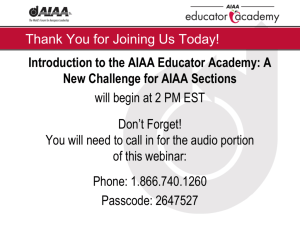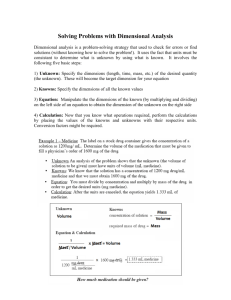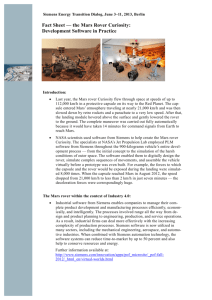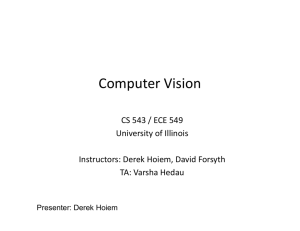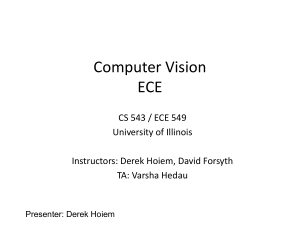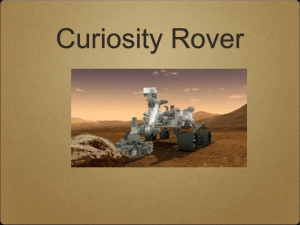the presentation - American Institute of Aeronautics and
advertisement
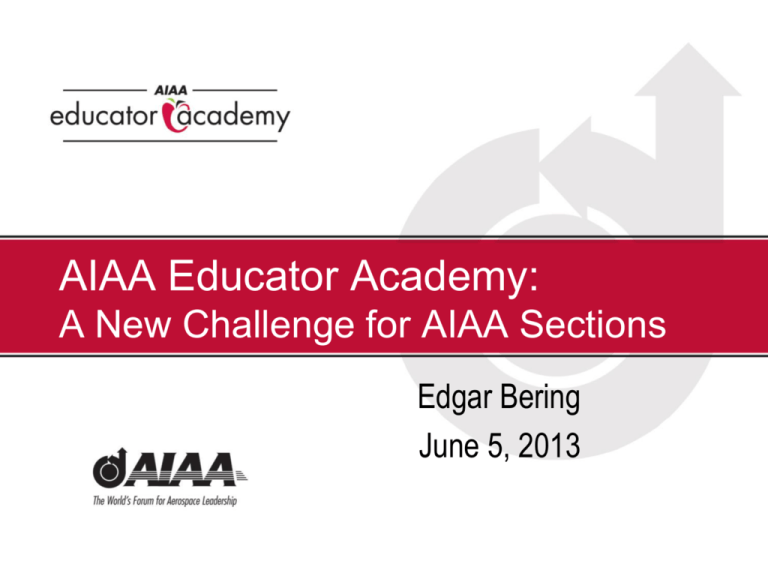
AIAA Educator Academy: A New Challenge for AIAA Sections Edgar Bering June 5, 2013 Outline • Academy Overview • The Three Modules Mars Rover Celebration Electric Cargo Plane Space Weather Balloon • Starting an Academy Program Miniworkshop Full Workshop Capstone Events The Problem • Effectively inspire K-12 students to pursue STEM careers • Engage our Educator Associates with AIAA members Strategic Goals • Engage 65% of the AIAA membership in STEM K-12 Outreach Market research indicates 52% actively want to help with outreach right now! • Engage 8 million students per year with an AIAA volunteer or in an AIAA activity Trivial if Goal 1 is attained • To reach all kids, need high volume programs that can be run far from our population centers One Solution • Use a series of Curriculum Modules that will teach engineering-related concepts in fields such as aeronautics, astronautics and robotics (STEM) • This regional program will increase interaction among Educator Associates, AIAA Professional Members, K-12 students, and the local community The Layers Regions and Sections Educator Associates and Section Mentors impacting thousands of Students The Objectives • Publish AIAA-approved, standards-aligned curriculum modules that convey the wonder and excitement of careers in aerospace. The first three of these have been published. • Have these curricula adopted on a long term basis in many schools. • Engagement with the schools that are using the curricula by their local sections. • Quantitative efficacy assessments from the teachers using the materials. The Modules • Mars Rover Originated in Tucson Section Matured by Houston Section • Tethered Electric Cargo Plane Mid-Atlantic Section • Space Weather Balloon Houston, Michigan, Northern NJ Sections, with others 8 Mars Rover Celebration Students design and build a Mars Rover to carry out a specific science mission on the surface of Mars. • Grade Levels: 3-5 and 6-8 • Contact: Dr. Edgar Bering University of Houston EABering@uh.edu Electric Cargo Planes Students design and build an electric cargo plane that carries the maximum amount of payload • Grade Levels: 6-8 and 9-12 • Contact: Tom Milnes, MSEE JHU Applied Physics Lab Thomas.Milnes@jhuapl.edu Space Weather Balloons Students design and build a space weather balloon to collect data • Grade Levels: 9-12 • Contact: Dr. Ben Longmier Assistant Professor, University of Michigan Longmier@umich.edu The Reward Mars Rover Celebration Curriculum Module What is the Mars Rover Curriculum Module? • • • • • • • A six week inquiry based science curriculum for grades 3-8. Teams select a specific science mission on Mars. 15 5E Lesson Plans. All Lessons feature an Essential Question Science Notebook evaluation Standards Aligned Key Words and Reading Strategy What is Mars Rover Celebration? • • • • Primary and middle school (Grades 3-8) students design and build a model Mars rover. Teams select a specific science mission on Mars. The model is a mock-up of mostly found/recycled objects. Option to contain a low-cost solar-powered car kit ($10) or radio-controlled car ($25) may serve as the chassis. Standards & Skills • • • • • • • • • Science process skills Laboratory experience Investigation planning Data collection Inference Organization Communication Writing Teamwork Mars Rover Pedagogy Conceptual understanding can be delivered through both inquiry and direct instruction. Inquiry-based science instruction promotes a greater understanding of scientific investigation as a process. This approach supports the central goal of the Mars Rover Celebration—to promote long-term interest in STEM-related fields and careers. Cobern, W. W., Schuster, D., Adams, B., Applegate, B., Skjold, B., Undreiu, A., and Gobert, J. D. (2010). Experimental comparison of inquiry and direct instruction in science. Research in Science & Technological Education, 28(1): 81–96. http://www.wmich.edu/way2go/docs/Experimental%20comparison%20of%20inquiry%20and %20direct%20instruction%20in%20.pdf Mars Rover Pedagogy • Student choice should drive classroom activities & discourse. • Teachers should act as “guides” & “listeners” whenever possible. • Active exploration should precede explanation of new material. • Student experience and preconceptions should be recognized and addressed. • Divergent thinking should be actively encouraged. Mars Rover Celebration Event Why an Event? The Mars Rover Capstone Event • Helps to prepare children in a way that traditional classroom lessons cannot fully achieve • Students learn to work in teams over a period of time, accountability for project completion, presentation skills, and experience the scientific method in a fun and fulfilling activity • Students can participate in a STEMbased activity encompassing many individual interests. Getting Ready The Mars Rover Capstone Event • • Designed to be executed in a single classroom, one grade level, a school-wide competition, or a citywide event. Smaller school-level competitions help reduce the number of models in the city-wide competitions. Tethered electric cargo plane The 2nd Module is taught regularly. 22 Tethered Electric Cargo Plane • • • • • Exposes students to Aerospace Engineering Students study how to make things fly. Indoor setting No expensive Radio Control equipment A capstone event where the students compete to see which student or student team can lift the most cargo can be added. 23 Electric Powered Flight as a Learning Tool • Topics for Learning Newton’s Laws, Forces and Torques, Conservation of Mass, Momentum, and Energy, DC Electronics, Dynamics, Kinematics, Propulsion, Energy Conversion, Aerodynamics, Gravity, Stability, Equilibrium, Drag, Lift, Friction Why Tethered Flight? • Radio Controlled Airplanes Can Be Problematic for School Use Expensive Electromechanical Controls Needed Large Airfield and Good Weather Needed • Tethered Flight Solves These Problems Tethered Flight Concept Tether Power Supply Power Pole Clear Packing Tape • Constrained Flight Path - Can be done Indoors - Expensive RC Equipment not needed Flat Speaker Wire Electric Cargo Plane Challenge • Must complete one lap of tethered flight with and without cargo about the power pole Plane must be 8” off the ground at all times • Scoring MESA MEC Oral 30 30 Written 55 20 Design Performance 40 55 20 30 30 x Cargo/Best Cargo TOTAL 180 55 - Most Weight 50 - Next Most … 100 What You Get MANDATORY Kelvin Electronics 850647 3-6V, 17000 RPM, .26A http://www.kelvin.com $.79 each OPTIONAL Kelvin Electronics 990175 $5.75 per set of 8 What’s Needed • Power Pole - We recommend Kelvin 850747 - $175 http://www.kelvin.com • Power Supply Model Train Variable DC Transformer What’s Needed • Wings - Pink or Blue Foam Board - Home Depot $12 • Fuselage - Basswood or Graphite Kite Stay Where to Put Cargo • Don’t Want to Change Trim of Airplane • Should Add Cargo Such that Center of Gravity (“Balance Point”) Does not move Aerodynamic and Gravity Forces remain aligned so Airplane Remains Trimmed Practice, Practice • Successful teams will have experience flying, adjusting, and repairing planes Unlikely to do well if your plane hasn’t been tested with power pole • Teachers can use AIAA Grant Program to Obtain Power Pole and Power Supply Space weather balloons Project Aether: Aurora A precursor/test of concept for the new 3rd Module 33 Project Aether: Aurora Benjamin Longmier, Ph.D. Adjunct Faculty Physics Department University of Houston blongmier@uh.edu 281-526-0554 www.ProjectAether.org What we did • Send HD cameras up to the edge of the aurora borealis on our specially designed high altitude weather balloon platforms. • • • Would like to perform 10-30 launches into the aurora Fairbanks, Alaska Apr 2012 timeframe 14 day trip Take simultaneous video/photo data from 0km (ground) , 30km (balloon), and 400km (ISS) altitudes. Increase the technology readiness level of several science instruments in a relevant environment. Took advantage of low-cost off-the-shelf equipment to perform science work within the plasma environment of the aurora. The conditions at altitude will be Taken from the International Space Station Taken from the Space Shuttle Taken from the International Space Station 10 Torr (near vacuum) Low temperature (-80 C) Radiation from aurora and cosmic rays Taken from the ground, Alaska Measured Auroral activity, Fall 2010 Launch and Recovery: Fairbanks, Alaska Zone of typical Aurora activity Arctic Circle Magnetic North Pole Fairbanks, Alaska We have identified Fairbanks, Alaska as the ideal launch point due latitude, weather, travel costs and logistics, launch locations, and recovery locations Launch and Recovery Geography Landing and Recovery Area Tanana Valley Stage launches from these road locations (dashed line) Recovery Methods Recovery zone is largely snow covered arctic tundra • Few trees, Can be deep powder snow Method 1: Snow machine • • 15 mph, 50 mi range Plan to use for payloads that land within 20 miles of roads Method 2: Dogsled • • 5 mph, 15 to 30 mi range Plan to use for payloads that land within 15 miles of roads. Method 3: Helicopter • • • • • 115 mph, 200 mi range 4 hr flight time Plan to use for cameras that land in remote or difficult to reach areas Offers impressive views during recovery efforts Has to be warmer than -20 F for flying, engine is left running for safety during recovery operations Method 4: Cross country ski and snowshoe • 1-5 mph, 5 mi range Schedule • Trip length was two weeks, Mar 30 – Apr 15, 2012 • The Aurora in the northern hemisphere exist at some intensity all year round. However, you can only see them during the night. • The Aurora are also at their peak intensity during the winter/spring months • Weather is a competing factor Can’t be too cold (must be warmer than -20 F for helicopters) Can’t be too windy (causes difficulty for ground ops) Map of Auroral activity, Fall 2010 Education • 4 teachers blogged daily from Fairbanks • Daily contact with students via Skype / Google+ • • Curriculum Development for Grades K-12 Interdisciplinary units aligned to content standards STEM, Art, Social Studies • Collaboration of teachers involved with the Progressive Science Initiative Multi-state and International (Japan, Argentina) • • • Project Aether: Education website development (http://education.projectaether.org) Student developed science experiments to be launched on payload platforms Prototype testing for Space Weather Balloon module Project Aether: Aurora Summary What: Send 10+ HD HERO2 cameras into the Aurora Borealis on 10-30 high altitude balloon flights into the upper stratosphere. Where: Fairbanks Alaska and 100 mile surrounding radius. When: March 31 – April 15, 2012. Who: Principal Investigator, Benjamin Longmier, Ph.D. (UH); Edgar Bering, Ph.D. (UH); 8 undergraduate and 2 graduate researchers from Texas A&M; 2 high school teachers; 1 NASA astronaut on International Space Station. Support provided by GoPro. Why: Auroral science, technology development, and exploration-based student outreach. Contact: Benjamin Longmier, Ph.D., blongmier@uh.edu, 608-225-3173. www.ProjectAether.org Starting an Educator Academy Program in Your Section • Miniworkshop Section Council plus enough others to make 20 Introduce one module in detail • Full Academy Visit 6 hour Teacher Training Workshop Train the Trainers Workshop (leave a legacy behind) Train the Capstone Organizers Workshop This visit is mostly the Institute’s responsibility Starting an Educator Academy Program in Your Section • Capstone Regional Competition Provides incentive for teachers to use the whole curriculum Provides increased opportunity for Section-Teacher contact The Section’s job How to Webinar on July 11, 2013 • Mentoring TC and Engineers as Educators members provide content and teaching support • Follow Up Evaluations Curriculum Materials • Educator Academy Web Page https://www.aiaa.org/AIAAEducatorAcademy/ • Each Module has a Curriculum Materials publication and a Supply List • Links to Additional Resources are Provided How to Start • Contact Lisa Bacon (lisab@aiaa.org) and me, Edgar Bering (eabering@uh.edu) • Tell us you want to schedule a miniworkshop visit • Tell us which modules you are most interested in prioritize • Give us a range of dates Special Thanks • Curriculum modules developed in conjunction with our AIAA partners: The AIAA Mid-Atlantic Section The AIAA Houston Section The University of Houston The AdAstra Rocket Company • Special Thanks to our STEM K-12 Development Team: Ben Longmier Elizabeth Henriquez Tom Milnes Paul Wiedorn Edgar Bering Lisa Bacon Elana Slagle
